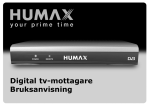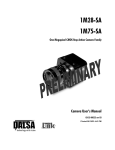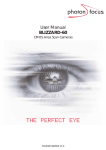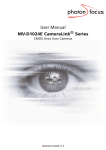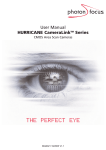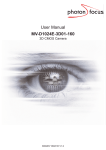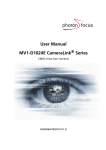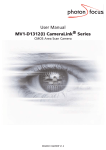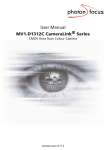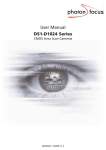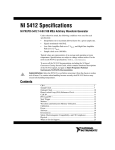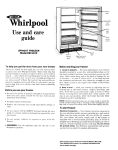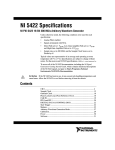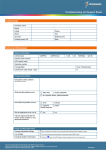Download User Manual - Stemmer Imaging
Transcript
MV-D1024-TrackCam User Manual REV: 1.1 PHOTONFOCUS AG Bahnhofstrasse 10 8853 Lachen Phone: +4155451000 Fax: +41554510001 www.photonfocus.com © 2004 PHOTONFOCUS MV-D1024-TrackCam User Manual Index 1. Introduction............................................................................................... 3 1.1 1.2 The MV-D1024-TrackCam.............................................................................. 4 Frame Grabber ............................................................................................ 4 2. How To Get Started .................................................................................... 5 3. Technical Data............................................................................................ 6 4. Camera Interface ....................................................................................... 7 4.1 4.2 Pin Assignments for the MDR26 Socket of the CameraLink Interface.................... 7 Pin Assignments for the Socket of the Voltage Supply Connector......................... 7 5. Basic Operation and Features..................................................................... 8 5.1 5.2 5.3 5.4 5.5 5.6 Configuration Interfaces................................................................................ 8 Exposure Control ......................................................................................... 8 Global Shutter ............................................................................................. 8 Region of Interest ........................................................................................ 8 LinLog and Skimming Mode ........................................................................... 8 Status Indicator ........................................................................................... 9 6. PFRemote................................................................................................. 10 6.1 6.1.1 6.1.2 6.1.3 6.2 6.3 6.4 6.4.1 6.5 6.6 6.7 6.8 6.9 6.10 About PFRemote Software ........................................................................... 10 Getting The Software ............................................................................... 10 Installing The Software ............................................................................ 10 Supported Operating Systems ................................................................... 10 Camera Initialization .................................................................................. 11 Stored Camera Configuration ....................................................................... 11 Exposure and Triggermodes ........................................................................ 12 Advanced Triggering Modes ...................................................................... 13 Window Of Interest .................................................................................... 14 MROI / Mask Mode ..................................................................................... 14 Characteristic Curves And Amplification ......................................................... 15 LUT Editor (Look-up Table).......................................................................... 16 LinLog and Skimming ................................................................................. 17 Calibration ............................................................................................. 18 7. Mechanical Dimensions ............................................................................ 20 8. Important Notes ...................................................................................... 21 8.1 8.2 8.3 8.4 Storage and Transport ................................................................................ 21 Declaration of Conformity............................................................................ 21 Package Content ........................................................................................ 22 Accessories ............................................................................................... 22 9. Service Information ................................................................................. 23 9.1 Guarantee Conditions ................................................................................. 23 9.1.1 Guarantee Claims.................................................................................... 23 9.1.2 Repair Time............................................................................................ 23 9.1.3 Claims for Damages................................................................................. 23 9.1.4 In Case of Damage .................................................................................. 23 9.1.5 Safety Hints ........................................................................................... 24 10. Literature ................................................................................................. 25 11. Document History .................................................................................... 26 REV: 1.1 Page 2/26 MV-D1024-TrackCam User Manual 1. Introduction High-speed megapixel CMOS camera for fast tracking applications The MV-D1024-TrackCam from Photonfocus is aimed at demanding applications in fast image processing. The highlight of this camera is the fast configuration interface. This makes it possible to use a frame-to-frame camera control with up to 40 Mbit/s, instead of the usual 9.6 kbit/s. The camera provides an exceptionally high dynamic range of up to 120dB at a resolution of 1024 x 1024 pixels and a frame rate of up to 75 full images per second. It is built around a CMOS image sensor that has been specially developed by Photonfocus. The principal advantages of the Photonfocus CMOS technology are: 1. Low power consumption at high speeds 2. Resistance to blooming, smear, and image lags 3. Extremely high image contrast achieved by LinLogTM technology With the fast configuration interface, in combination with ROI and LinLogTM technology, Photonfocus offers an absolutely unique product designed for: • Tracking of fast moving objects • Simultaneous inspection of different regions • Shot-to-shot definition of ROI, exposure time and LinLogTM settings • The MV-D1024-TrackCam is targeted to • Industrial (welding process, welding inspection, PCB inspection) • Sport (movement analysis, object tracking) • Research and development The compact size of only 55 x 55 x 46 mm³ makes the MV-D1024-TrackCam the perfect solution for applications in which space is at a premium. With the digital camera series, Photonfocus has proven that the image quality of modern CMOS sensors is now appropriate for a wide range of applications. Photonfocus is ISO 9001 certified. All products are produced with the latest techniques in order to ensure the highest degree of quality and to satisfy the requirements of our customers. REV: 1.1 Page 3/26 MV-D1024-TrackCam User Manual 1.1 The MV-D1024-TrackCam The MV-D1024-TrackCam is a high-end CMOS megapixel camera with global shutter. It has a fast configuration interface that lets you modify the most important camera configuration parameters at speeds up to 40 MBaud. The camera includes the following features: • CMOS Progressive scan global shutter, monochrome • Up to 75 fps full frame rate • LinLogTM Pixel with up to 120 dB dynamic range • CameraLink© -Interface • Internal Lookup Table • 8 Bit digital resolution • Region of interest (ROI) • Skimming: Mode in which small signal gain of a pixel is increased • Programmable via a high-speed Configuration Interface or an RS-232 serial port • Designed for frame grabber microEnableIII-fast configuration by Silicon Software. • C-Mount objective mount 1.2 Frame Grabber The MV-D1024-TrackCam is designed to be used with the microEnableIII-fast configuration frame grabber from Silicon Software. This special frame grabber version accesses the MV-D1024-TrackCam via the high-speed configuration interface. The camera is controlled and programmed with the frame grabber software. However it can be run with any Photonfocus-compliant frame grabber (see [FGLIST] in Literature). In this case the camera can be programmed with the tool PFRemote (see chapter 6), but fast configuration is not possible. REV: 1.1 Page 4/26 MV-D1024-TrackCam User Manual 2. How To Get Started 1. Remove the camera from its packing and ensure that it is complete and undamaged. If any damage has occurred during transport, please contact the transport company and your distributor immediately. 2. Connect the camera to the microEnableIII-fast configuration frame grabber with a suitable CameraLink© cable. Important Note: Only cables can be used where each wire-pair is shielded. Thus the following Phontonfocus cables cannot be used: Part no. 704020.052 and 704020.102. Warning: Do not connect or disconnect connections while camera power is on. 3. The camera is delivered with a 3-pole power plug. Ensuring that the maximum operating voltage is not exceeded, connect the camera to a suitable power supply (+5V DC +/-10%). 4. To use the camera in the Fast Configuration mode, please read the “getting started” section of the Silicon Software Fast Configuration manual ([ME_FC]). 5. Additional functions can be programmed with the PFRemote tool (see chapter PFRemote) or with Photonfocus pflib, delivered with PFRemote tool. REV: 1.1 Page 5/26 MV-D1024-TrackCam User Manual 3. Technical Data Technical Data for the MV-D1024-TrackCam Number of pixels Pixel size Optically active area Optical diagonal Objective mount Characteristic Full well capacity Sensitivity Noise Fixed Pattern Noise Dynamic range in linear mode Dynamic range in LinLogTM mode Analog amplification Spectral range Optical fill factor Data interface Data resolution Pixel clock Internal pixel clock External clock rate CameraLink interface Maximum frame rate Shutter type Exposure time Configuration interface High-Speed configuration interface Voltage supply Power consumption Dimensions Weight CE Test 1024 x 1024 10.6 µm x 10.6 µm 10.9 mm x 10.9 mm 15.42 mm Î 1” Standard optics C-mount Linear or LinLogTM adjustable 200 ke10 µJ/m2/LSB @ 630 nm, 8 bit < 0.5 Grey level standard deviation @ 8 bit < 3 Grey level standard deviation @ 8 bit > 48 dB @ 8 bit > 120 dB 1 or 4 400 nm – 900 nm (see Fig. 1) 35% CameraLink 8 bit, or 9 to 8 bit LUT 2x40 MHz 4x20 MHz 10 MHz to 20 MHz 75 fps @ Tint = 10 µs global shutter 1 µs – 0.5 s in steps of 50 ns RS232 Standard, 9600 baud, 1 Start bit, 1 Stop bit, no Parity bit Synchronous transmission < 40MBaud, 1 Start bit, 1 Stop bit, no Parity bit +5V DC +/-10% 2W 55 mm (B) x 55 mm (W) x 50 mm (H) 200g Approved (see chapter 8.2) Fig. 1: Quantum efficiency as function of wavelength REV: 1.1 Page 6/26 MV-D1024-TrackCam User Manual 4. Camera Interface The MV-D1024-TrackCam is equipped with a CameraLink interface in the base configuration. 4.1 Pin Assignments for the MDR26 Socket of the CameraLink Interface PIN I/O Name Description 1 2 3 4 5 6 7 8 9 10 11 12 13 14 15 16 17 18 19 20 21 22 23 24 25 26 S SHIELD N_XD0 N_XD1 N_XD2 N_XCLK N_XD3 P_SERTOCAM N_SERTOFG N_CC1 P_CC2 N_CC3 P_CC4 SHIELD SHIELD P_XD0 P_XD1 P_XD2 P_XCLK P_XD3 N_SERTOCAM P_SERTOFG P_CC1 N_CC2 P_CC3 N_CC4 SHIELD SHIELD Shield Negative LVDS Output, CameraLink Data D0 Negative LVDS Output, CameraLink Data D1 Negative LVDS Output, CameraLink Data D2 Negative LVDS Output, CameraLink Clock Negative LVDS Output, CameraLink Data D3 Positive LVDS Input, Serial Communication to the camera Negative LVDS Output, Serial Communication from the camera Negative LVDS Input, External Trigger signal EXSYNC Positive LVDS Output, not used Negative LVDS Input, serial clock (Fast configuration interface) Positive LVDS Input, data (Fast configuration interface) Shield Shield Positive LVDS Output, CameraLink Data D0 Positive LVDS Output, CameraLink Data D1 Positive LVDS Output, CameraLink Data D2 Positive LVDS Output, CameraLink clock Positive LVDS Output, CameraLink Data D3 Negative LVDS Input, Serial Communication to the camera Positive LVDS Output, Serial Communication from the camera Positive LVDS Input, external Trigger signal EXSYNC Negative LVDS Input, not used Positive LVDS Input, serial clock (Fast configuration interface) Negative LVDS Input, data (Fast configuration interface) Shield Shield PW O O O O O I O I I I I PW PW O O O O O I O I I I I PW PW 4.2 Pin Assignments for the Socket of the Voltage Supply Connector PIN I/O Name Description 1 2 3 PW PW PW VDD GND VDD2 + 5 V voltage supply Ground Reserved 3 1 2 Connector socket Nr. 09-0408-90-03 for the voltage supply REV: 1.1 Page 7/26 MV-D1024-TrackCam User Manual 5. Basic Operation and Features Note: The high-speed interface can be accessed by the microEnableIII-fast configurationframe grabber. In this case not all functions described in this section are available or are replaced by default values (see [ME_FC]). 5.1 Configuration Interfaces The MV-D1024-TrackCam can be programmed via a: • High-speed interface (up to 40 MBaud) that lets you modify important camera configuration parameters with the maximum frame rate. Note: this interface is designed for the microEnableIII-fast configuration frame grabber. • A RS232-interface working at 9600 Baud (included in CameraLink© interface). 5.2 Exposure Control Note: When using the high-speed interface, exposure is controlled by the microEnableIIIfast configuration frame grabber. Exposure can be controlled by applying external synchronisation signals (see section 6.4). A free-run mode is also available. 5.3 Global Shutter The sensor used in the MV-D1024-TrackCam uses a global shutter, i.e. all pixels are exposed at exactly the same time. 5.4 Region of Interest With the MV-D1024-TrackCam camera, it is possible to increase the image data rate by reading out only a part of the pixel matrix. The user can define a region of interest (ROI) within the sensor to be transmitted to the frame grabber and thus higher frame rates can be achieved. 5.5 LinLog and Skimming Mode The LinLogTM CMOS image sensor from Photonfocus employed in the MV-D1024TrackCam allows the user to adapt the characteristics of the sensor to the requirements of the application. • Linear mode: For normal applications that do not require high contrast, the sensor can be operated in linear mode. • Skimming mode: For applications having short exposure times and low illumination intensity, it is advisable to activate skim mode, in which a non-linear amplification, similar to a gamma correction, occurs in the pixel so that small signals are amplified significantly more than large signals. • LinLogTM mode: In situations involving high intrascene contrast, compression of the upper grey level region can be achieved with the LinLogTM Technology. At low intensities, each pixel shows a linear response. At high intensities, the response changes to logarithmic compression. The transition region between linear and logarithmic response can be smoothly adjusted and is continuously differentiable. Skimming and LinLogTM can be combined to achieve maximum control of the sensor output. Please refer to application note [AN001] for detailed information on the setting of LinLogTM. REV: 1.1 Page 8/26 MV-D1024-TrackCam User Manual 5.6 Status Indicator A two color LED on the rear of the camera indicate the camera status to the user. In normal operation the LED lights green when an image is being produced. At low frame rates a flickering can be observed that changes to a continuous light at high frame rates. Since the light intensity is dependent on the relation between exposure time and readout time, the light from the LED can practically disappear when using small ROI and long exposure times. A red LED indicates that serial communication on the RS232-interface is active. REV: 1.1 Page 9/26 MV-D1024-TrackCam User Manual 6. PFRemote 6.1 About PFRemote Software The MV-D1024-TrackCam can be programmed with the tool PFRemote which uses the CameraLink© RS232-interface. Note: To use the high-speed configuration interface you need the microEnableIII-fast configuration frame grabber from Silicon Software. Please refer to the frame grabber manual ([ME_FC]). In this case the camera is programmed by the frame grabber software. However there are functions that can only be programmed by PFRemote software. Warning: Do not use PFRemote while using the high-speed interface! 6.1.1 Getting The Software The latest version of the PFRemote software can be downloaded at: http://www.photonfocus.com/html/eng/support/software.php 6.1.2 Installing The Software Run the PFRemote_SDK executable to start an installation wizard which guides you through the installation. Framegrabber selection: Select Silicon Software menable3 from the drop-down list. 6.1.3 Supported Operating Systems • Windows 2000, Windows XP REV: 1.1 Page 10/26 MV-D1024-TrackCam User Manual 6.2 Camera Initialization On start, PFRemote displays a list of available communication ports (see figure below). Double-click on siso0 if your camera is connected to the input A of the Silicon Software framegrabber, double-click on siso1 if your camera is connected to the input B. Once the camera has successfully been opened, the camera type is displayed. Further options appear on right click on the camera entry: Info Shows some camera information Reset Resets the camera Close Closes camera and frees communication port 6.3 Stored Camera Configuration This section describes the buttons that appear on the right hand side of the PFRemote window, please see also application note [AN004]. Reset to Defaults Resets the camera and re-reads default (EEPROM) values into the configuration dialog box. Store in EEPROM Store current settings in EEPROM as boot-up values. Factory Reset Recover factory settings from EEPROM. This can take some time. Please note: Some configuration parameters such as LinLogTM and Skimming values can not be read out, therefore the displayed values might not be correct. To make sure the display is synchronized, you have to reset the camera manually via the Reset to Defaults button. REV: 1.1 Page 11/26 MV-D1024-TrackCam User Manual 6.4 Exposure and Triggermodes Free Running Free Running Mode; the camera generates consecutive frames whose rate is determined by the set exposure time resp. frame time. Extern Sync External synchronization through EXSYNC signal. Advanced Set advanced triggering modes (see below) Constant FrameRate For free-running mode only: If this flag is set, the frame rate is determined by the frame time which can be set below. Otherwise, the camera will immediately deliver another frame after the sensor exposure. LinePause This is the horizontal blank time in number of pixel clock cycles. Some frame grabbers require larger numbers than the standard default 8 (fastest). If your frame grabber displays artefacts, increase LinePause. Exposure Time Exposure time in milliseconds. The slider allows to choose a value within the camera's possible range in a nonlinear way. Note that the frame time slider may be adjusted if the chosen exposure time requires so - read below Frame Time If Constant FrameRate is set, the frame rate is determined by the given frame time in milliseconds. Note that, if this time is less than the exposure time, the Exposure Time slider will be adjusted. Frame Rate The calculated frame rate in frames per second [fps] The frame rate display is updated whenever a relevant value is changed. This value can not be edited (use frame rate slider and Constant FrameRate mode for precise frame rate control). REV: 1.1 Page 12/26 MV-D1024-TrackCam User Manual 6.4.1 Advanced Triggering Modes Important: There are restrictions on the LinLogTM functionality with some triggering modes, except Ext. Trigger with programmed exposure. In all other cases, the COMP value must be set to 0.0 in order to have LinLogTM work correctly. Other values may show no effect. Slave mode External Master clock synchronization via the MCLK wires. Sync pulses high active This is the default. If deselected, the trigger signals must be inverted (and the schemes below must be thought inverse as well) Ext. Trigger with programmed exposure On sync pulse start, the programmed exposure (slider ExposureTime) begins. Ext. Trigger exposure start, Exp stop Not available in TrackCam. Combined Trigger/Exposure The length of the ExSync pulse determines the exposure time. REV: 1.1 Page 13/26 MV-D1024-TrackCam User Manual 6.5 Window Of Interest The Window Of Interest (WOI) (also called region of interest) is defined as a rectangle [x, y, w, h] where x X coordinate of upper left corner, starting with 0 y Y coordinate of upper left corner, starting with 0 w Width of window h Height of window The rows and columns are counted beginning at 0, i.e. the last row and the last column have the address 1023. Please note that certain restrictions apply to the start and stop value of horizontal direction (X): If this is not the case, the LinePause value is automatically increased to avoid image artefacts. The LineHopping attribute defines the line readout stepping. For example, a number of 2 skips all odd lines. 6.6 MROI / Mask Mode When activated, the MROI mode applies a maximum number of 16 masks to the current window of interest. A mask is defined as a range of scan lines which are skipped and not read out which further speeds up the image acquisition. Note that mask windows may not overlap and are not checked for sanity. The parent window (Main WOI) must include the first mask, but may exclude trailing, unused masks. A mask is defined by its Y start value and the height H. These are entered analogous to the main ROI. REV: 1.1 Page 14/26 MV-D1024-TrackCam User Manual As an example, the greyed out areas on the 'zebra 5' denote the mask areas. The read out result in the frame grabber is displayed on the right (the black lines are just displayed to better visualize the seams). Picture with 4 masks 6.7 Resulting 5 image stripes Characteristic Curves And Amplification High Gain Toggle High Gain amplification. Resolution Choose camera ADC resolution (bit depth), LUT or LFSR (Random test pattern). LUT slot Switch to LUT number n Edit LUT Open LUT editor window (see below) REV: 1.1 Page 15/26 MV-D1024-TrackCam User Manual 6.8 LUT Editor (Look-up Table) The LUT editor allows to create look-up tables which digitally re-map intensity values to other values. The value conversion is directly done on the camera, whereas an input range [0, n] (n according to camera bit depth) is mapped to a output range of [0, 255]. The LUT editor displays either spline curves or free points (whereas the free point display is not very accurate, since the input values can cover a greater range than the canvas display's size in x). The input range is [0 ... 511]. Editing of the LUT curve happens by dragging the control points in Spline mode or simply painting on the window in Free mode. Once the curve is ready to be uploaded, you should first test it in the camera's RAM (Default). Pressing Send uploads the LUT data to the camera (which can take some time, depending on the frame grabber dependant implementation of the serial communication). If LUT mode is not enabled, it is automatically turned on. The LUT finally can be stored in one of the [m] available EEPROM slots of the camera by selecting the destination with the chooser right next to the Send button. Further, LUT tables can be downloaded (Receive) from the camera and stored to disk. Depending on the curve mode, the curve parameters are either [Spline mode]: Saved in a LUT spline set by entering the setting name in the LUT spline sets choice and pressing Save [Free mode]: Saved in a readable ascii hex code dump file. If in spline mode, a set simply can be chosen from the drop down choice. Entries can be erased with the Delete button. REV: 1.1 Page 16/26 MV-D1024-TrackCam User Manual 6.9 LinLog and Skimming The LinLogTM feature provides a semi-logarithmic, adjustable behaviour of the camera characteristics, so that extreme white intensities can be monitored without saturation while keeping optimum resolution on dark areas. Note that the LinLog state might not be known to the application after opening the camera configuration dialog. Therefore, the LinLog Control choice displays "Default". Use this choice to turn LinLog off or explicitely on, or reset the camera (Reset to Defaults) to update the current default settings. The Skimming slider is only accessible after a explicit update of the settings. Quick steps for LinLog™ adjustment (refer to application note [AN001]): Choose LinLog Control: LinLog2. Default stands for the default setting which is only well defined if the camera is reset, since LinLog values can not be read back. The LinLog setting makes only use of the LL1 parameter; see below. Set the LinLog high compression LL1 to a value such that your maximum intensity spot in the image resolves well or just starts to show bright gray. Set the low compression LL2 to a value less than LL1. Fine tune the COMP fraction value around small values in the range of [0, 100] to achieve an image with optimum dynamical resolution in high intensity ranges. This may require some iteration through the settings. The Skimming mode allows to brighten up darker areas (non-linear). REV: 1.1 Page 17/26 MV-D1024-TrackCam User Manual 6.10 Calibration Normally, the camera does not need to be calibrated as this is done after manufacture. In some cases recalibration or detuning by purpose might be desired. The calibration dialog is called via the Menu Camera->Calibration. Voltage changes can always be undone by restoring the factory defaults via the configuration dialog. Entries which are greyed out can not be changed by the user. Offset LowGain The black level offset voltage for the LowGain setting (i.e. HighGain off Offset HighGain Black level offset voltage for HighGain setting For calibration, you need a frame grabber software with real time histogram functionality. It is also possible to do the calibration by looking at the minimal gray value of the grabbed image. The standard procedure: 1. Make sure that the sensor is receiving no more light by either covering the C mount with the usually included protection cap or by closing the iris of the C mount lens. Set camera exposure time to minimum. 2. Make sure that HighGain is turned off and change the LowGain offset voltage such that the black level peak displays as in the left image below. 3. Same for HighGain: Activate HighGain via the check box and change the offset such that the black level distribution looks like in the image on the right. 4. Store the values in the EEPROM via the Store in EEPROM button. REV: 1.1 Page 18/26 MV-D1024-TrackCam User Manual LowGain mode histogram HighGain mode histogram The Skimming is normally changed in the LinLog panel but can be changed here as well, if the camera is run in skimming mode by default. In this case, the offset voltage may need to be adjusted. Note that the skimming effect is reverse to the voltage, i.e. higher voltage means: less skimming. Note that with too low skimming voltage settings, the image may no longer look good. Handle with care. REV: 1.1 Page 19/26 MV-D1024-TrackCam User Manual 7. Mechanical Dimensions REV: 1.1 Page 20/26 MV-D1024-TrackCam User Manual 8. Important Notes Photonfocus reserves the right to make changes to its products without notice. Photonfocus products are neither intended nor certified for use in life support systems or in other critical systems. The use of Photonfocus products in such applications is forbidden. Photonfocus, LinLog, LinLog2 and CameraLink are registered trademarks in Switzerland and in other countries. 8.1 Storage and Transport During storage and transport, the camera should be protected against vibration, shock, moisture and dust. The original packing protects the camera adequately from vibration and shock during storage and transport. Please either retain this packing for possible later use or dispose of it according to local regulations. 8.2 Declaration of Conformity We, the manufacturer Photonfocus AG, Bahnhofplatz 10 CH 8853 Lachen Switzerland Europe hereby declare that the products of the camera MV-D1024-TrackCam, released in 2004, conforms to the following standards or other normative documents: • EN61000-6-2 • (2001) • EN61000-6-3 • (2001) • EN61000-4-2 • (1995) • EN61000-4-3 • (1996) • EN61000-4-4 • (1995) • EN61000-4-6 • (1996) • EN55022 • (1994) This declaration becomes void in case of any changes on the product without written authorization by Photonfocus. REV: 1.1 Page 21/26 MV-D1024-TrackCam User Manual 8.3 Package Content The package includes the following: • Camera • Lens protective cap • enclosing note • Power supply connector Photonfocus reserves itself the right to change the content at any time without indication of reasons. 8.4 Accessories For the camera MV-D1024-TrackCam are several accessories available. For detailed information about the listed parts refer to the Photonfocus Web page www.photonfocus.com. • CLB 26 Digipeater – CameraLink Repeater for extended cable length • CameraLink cables • Power supply REV: 1.1 Page 22/26 MV-D1024-TrackCam User Manual 9. Service Information For product enquiries and quotations, please contact one of our distributors in your area. A list of distributors can be found on our web-site: www.photonfocus.com Product information, documentation and software updates can also be found on our website. 9.1 Guarantee Conditions 9.1.1 Guarantee Claims The manufacturer alone reserves the right to recognize guarantee claims. The guarantee will be rendered null and void in the event of unauthorized manipulation, mechanical damage or damage arising from inappropriate use or from mechanical or electrical modifications, especially soldering. The guarantee will also be invalidated if the apparatus is used for purposes for which it was not designed, if it is incorrectly connected or if it is not used according to the operating instructions. Guarantee work can only be assured and carried out by the manufacturer. 9.1.2 Repair Time Repair time will normally be a maximum of 10 working days for repairs to a device for which a legitimate guarantee claim is made. 9.1.3 Claims for Damages Claims for damages of all kinds, especially those arising from use, are excluded. Liability is limited, in all cases, to the value of our product. 9.1.4 In Case of Damage If the equipment is defective, return it, in the original packing and with a copy of the receipt, to the following address: Photonfocus AG Bahnhofplatz 10 CH-8853 Lachen Important: Include a written description of the fault as well as your full postal address. The equipment will be forwarded in your name to the service department and, in the event of a legitimate guarantee claim, returned to you without freight charges. REV: 1.1 Page 23/26 MV-D1024-TrackCam User Manual 9.1.5 Safety Hints The apparatus conforms with approved electro-magnetic standards. Opening the apparatus is not permitted. Furthermore, all guarantee claims will be invalidated by inappropriate use. In all circumstances, the following should be noted: • The apparatus may only be used for the purpose described. • The apparatus is only suitable for indoor use. Protect it from moisture and heat. • The permitted operating temperature range is 0°C to 60°C. • Never attempt repairs yourself. Repairs may only be carried out by trained expert staff. • Moreover, every piece of equipment is tested before delivery and has a guarantee symbol attached. • For cleaning purpose, use only a dry soft cloth. Never use water or chemicals. REV: 1.1 Page 24/26 MV-D1024-TrackCam User Manual 10. Literature [AN001] Application note AN001 “LinLog 2” found on http://www.photonfocus.com/html/eng/support/applicationNotes.php [AN004] Application note AN004 “Reset Strategies” found on http://www.photonfocus.com/html/eng/support/applicationNotes.php [FGLIST] Frame grabber compatibility list http://www.photonfocus.com/html/eng/support/framegrabbers.php [ME_FC] REV: 1.1 User Manual for microEnableIII-fast configuration frame grabber, Silicon Software ( http://www.siliconsoftware.de) Page 25/26 MV-D1024-TrackCam User Manual 11. Document History Document revisions REV Changes Date 1.0 1.1 First revision Added note that mode “ext. trigger, exposure start, Exp stop” is not available. Slight modifications in Getting started chapter 2004-05-17 2004-07-07 REV: 1.1 Page 26/26


























![GammaWare[Gw] User's Guide](http://vs1.manualzilla.com/store/data/006910084_1-8196ffa7e35032d3615309d6abf1f30d-150x150.png)


